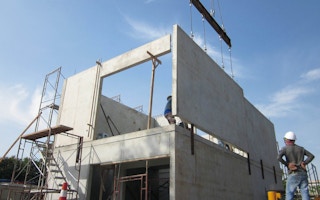Indonesia is experiencing a boom in demand for new homes, led by a population that is growing by about 1 per cent a year and an economy that it set to grow by 5 per cent annually.
This demand, though, is putting a tremendous strain on the environment.
According to estimates by the United Nations Environment Programme (UNEP), buildings consume 40 per cent of energy and another 40 per cent of global resources. Around a third of greenhouse gas emissions in the world also come from buildings.
As a response to the growing need for quality homes even while reducing environmental impact, PanaHome has developed a construction method which reduces the amount of resources consumed by buildings as well as the time needed to build it.
The housing arm of Japanese electronics company Panasonic – which has over 50 years’ experience of building half a million homes in Japan – has identified Southeast Asia, and in particular, Indonesia, as a key market for this technology.
Last month, PanaHome Asia Pacific, together with PT. Gobel International (GI) launched a new joint venture called PanaHome Gobel Indonesia (PHGI) focused on rolling out housing technologies and solutions in the local residential development, construction and interior furnishing markets.
Toru Nishida, managing director of Panasonic Asia Pacific, says he believes that the establishment of PHGI will kick-start the replication of the company’s successful projects in Japan, such as Fujisawa Sustainable Smart Town, located 50km to the south of Tokyo.
In April last year, about 900 Fujisawa residents moved into smart homes with solar panels on the roof, fuel cells in their backyard and an integrated home energy management system that ensures the comfort of its owners without sacrificing energy efficiency.
When fully completed in 2018, the town - built at a total cost of 60 billion Japanese yen (US$500 million) – will have 3,000 people in 1,000 homes, complete with shopping facilities, community centres and nursing facilities for the elderly.
“We believe our security systems and energy management technologies can make homes safer, greener and more sustainable,” says Nishida.
Enter W-PC
The company’s Japan-originated method of construction called “wall pre-cast concrete” (W-PC) is key to their business strategy in constructuring low-rise homes in Southeast Asia.
The technology is specifically modified for the Southeast Asia region although it could be tweaked for use in other regions in the future.
Using the W-PC method enables builders to shave as much as three months’ worth of construction time off the total time needed to build the homes, depending on the size of the property.
This is made possible thanks to the fact that PanaHome can build a W-PC factory situated on a project’s development site.
At this temporary factory, the building’s exterior components such as flooring slabs, walls and roofs are fabricated by pouring concrete into steel moulds, then assembled using a crane.
Construction of the property can also commence immediately on-site upon completion of pre-casted materials, saving builders precious time and reduce logistical, transportation and environmental costs. In this process, construction waste is also reduced.
Once the property is completed, the W-PC factory will be removed.
This method of construction vastly improves on traditional procedures, which typically involve industrial trucks transporting mega blocks of pre-cast elements made at a fixed factory located away from the construction site.
PanaHome’s buildings are also designed to be energy efficient and environmentally friendly, consuming less electricity than other homes of similar size and design.
“
We believe our security systems and energy management technologies can make homes safer, greener and more sustainable.
Toru Nishida, managing director, Panasonic Asia Pacific
The heat insulation materials are installed on the external wall and ceiling at the top floor, enabling homes to be completely insulated and lower temperatures by 3 deg Celsius, according to PanaHome’s experience in building homes in Malaysia
This reduces the energy consumption as air conditioners do not need to work so hard in cooling the homes down.
PanaHome also uses the PureTech ventilation system which filters out dust and air pollutants, keeping indoor air fresh for the occupants. It can remove up to 95 per cent of harmful air particles.
Indoor air accounts for about 60 per cent of all substances taken in by humans daily, making it crucial for it to be kept clean and healthy.
Eye on Indonesia
Kazuhiko Tanaka, managing director of the joint company PHGI says that Panasonic is eyeing the Indonesian market as being ripe for the adoption of its pre-cast technology.
“Indonesia’s population is estimated at 258 million, the largest among the 10 Asean countries. Even with new properties being built annually, supply of quality housing is still limited,” he observes.
“Every year, the economy is growing at approximately 5 per cent. We believe it is crucial to aid development of the country’s infrastructure,” he adds.
Panasonic has a long and rich history with Gobel International in Indonesia since 1960. The launch of this joint venture is “symbolic of our commitment to this strategic market and our goal of becoming a more solutions oriented company”, says Tanaka.
Panasonic started out in Indonesia in 1960, selling mainly home appliances such as television sets. Over time, its line-up of products expanded to include air conditioners, refrigerators and washing machines.
The company has plans to introduce its technologies to promote smart homes in Indonesia. These efforts will mainly focus on township development, with the aim of building Japanese-quality homes that can last a lifetime, says the firm.
Click here to find out more about Panasonic Asia Pacific and to receive updates.



















